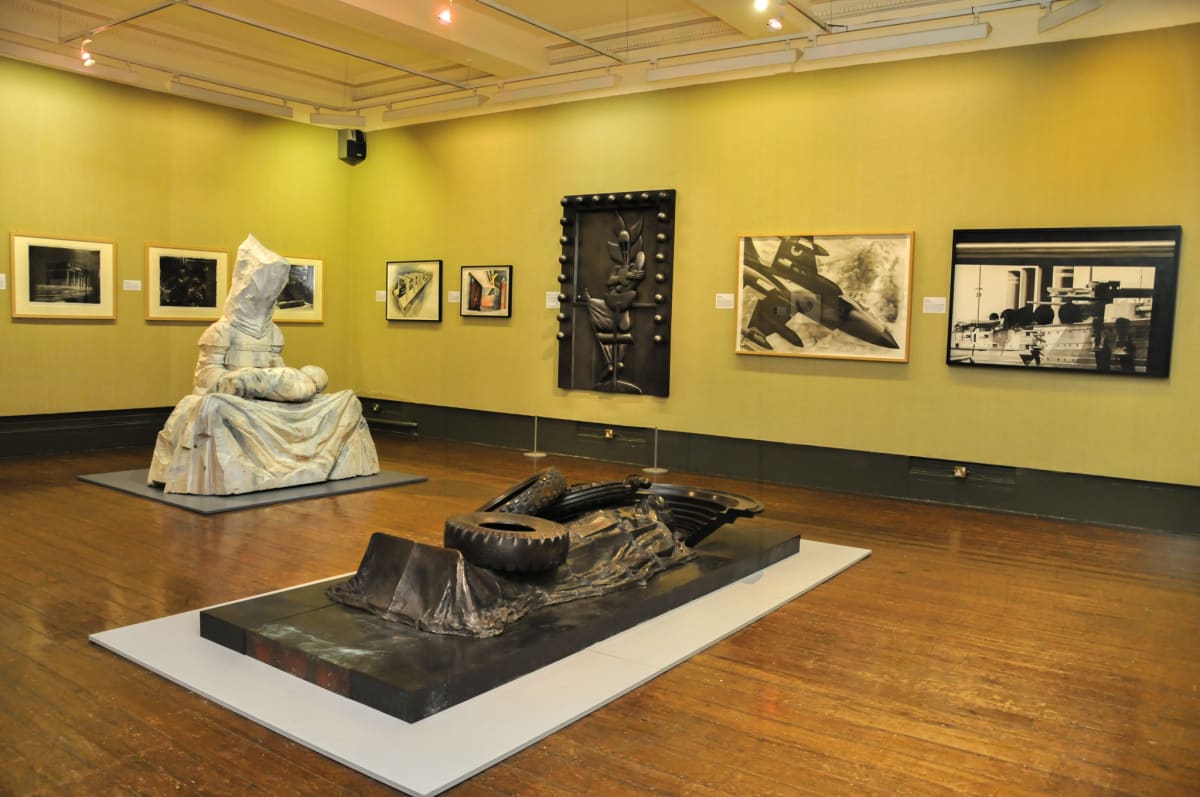Michael Sandle Monumental Rage
Professor Michael Sandle RA, who studied at Chester School of Art, is widely recognised as one of the finest sculptors in the world and is also a brilliant draughtsman and printmaker. Chester’s Grosvenor Museum is proud to present an exhibition of his work, ‘Michael Sandle: Monumental Rage’, running from 19 May to 7 October.
Michael Sandle’s work explores the themes of violence, war, death and memorialisation, making this a particularly appropriate exhibition for the year in which we commemorate the centenary of the end of the Great War. In direct response to the horrors of our age, his art presents a powerful critique of the abuse of power in global conflict, politics and culture, and the accompanying cynicism and hypocrisy.
The exhibition shows the immensely powerful work of this important artist, whose international status is unmatched in his field by any other British artist of his generation. With sculptures, drawings and prints spanning sixty years, it offers an extraordinary aesthetic, intellectual and emotional experience for the museum’s visitors.
Exhibition
The deeply moving 2009 limewood carving ‘Iraq – The Sound of your Silence’ is two metres high and apparently hewn from a single block. Drawing on images of a mother cradling a baby whose hands had been blown off, and prisoners with bags over their heads, Sandle has created a Pietà for the victims of the Iraq War. It is one of his greatest achievements.
Another monumental work is the 2015 bronze ‘As Ye Sow So Shall Ye Reap: An Allegory (Acknowledgements to Holman Hunt)’. The figure of Christ from the Victorian painting
‘The Light of the World’ is transformed into an F-16 fighter pilot holding the severed heads of five girls, a powerful denunciation of the hypocrisy of Western military involvement in the Middle East.
Before that lies the three-metre long ‘Caput Mortuum: A Commentary’ 1983. Amid the ruins of the Falklands War, a soldier’s corpse lies beneath a sheet, strewn with tyres like commemorative wreaths and with a microphone at his blindfolded head representing the mechanisms of media broadcasting.
A cluster of plinths present proposals for monumental memorials on the theme of death and destruction, dating from 1980-3, their shrouded figures marking a long running fascination with the anonymous body representing both personal subjectivity and shared universal experience.
One gleaming unpatinated bronze contrasts with the other sculptures. ‘The Suicide or He Took the ‘A’ Train’ 1995/2016 was inspired by the story of a man who committed suicide by climbing onto the roof of an electric locomotive, the electrical currents coursing through him like Baroque shafts of light.
Sandle’s 1999 ‘Maquette for Animals in War Memorial’ exemplifies, in condensed form, the civic magnificence of his work. ‘Proposal for Euston Road No.2’ 1985 dynamically interweaves diagonals, verticals and Art Deco zigzags, while ‘Burning Façade’ 1994 is an uncanny premonition of the destruction of the World Trade Center.
Two wall-mounted bronzes, ‘Studies for Big Brother I and II’ 1984, relate to Sandle’s unexecuted commission for an Orwell Memorial in Wigan. Depicting the face of Big Brother emerging as if from a television screen, Sandle equates television with Big Brother as an insidious negation of individual freedom.
Sandle is an exceptional draughtsman, his virtuoso combination of pen-and-ink drawing with watercolour juxtaposing incisive line with subtle gradations of tone. Three monumental works in acrylic and watercolour, ‘Mount St Helens I-III’ 1982, convey the majestic but destructive power of nature in this cataclysmic volcanic eruption.
Sandle’s love of ink is reflected in his skill as a printmaker. His 1979 etching and aquatint ‘Bunker in Moonlight’ shows a moonlit view across water to a flooded concrete submarine bunker, this seemingly disused relic of the Second World War providing a sense of shadowy foreboding in the age of the Cold War.
Much of Sandle’s work has been inspired by listening to his favourite composers, Wagner, Bruckner and Mahler. Their music, with its vast scale, richness and complexity, complements his work, creating a suitably Germanic ‘gesamtkunstwerk’ or total aesthetic experience.
The Art Gallery presents a rich ensemble of paintings, sculpture and furniture spanning half a millennium of art. Permanently displayed here beneath a huge Flemish Baroque mythology is Sandle’s 1981 bronze ‘Catafalque for Anton Bruckner’, the finest of his catafalques and the most important post-Roman sculpture in the museum.
Catalogue
The exhibition is accompanied by a lavishly illustrated book. Essays by John McEwen, Dr Cian Quayle, Dr Jon Wood and Dr Thomas Hirsch are followed by a full catalogue of the exhibits and complete listings of Michael Sandle’s exhibitions, commissions, awards, public collections and publications. The book offers a wealth of contextual information on the artist and his work, provides a permanent record of the exhibition, and forms a major reference work of lasting value. The publication of the catalogue has been largely funded by the Finnis Scott Foundation.
Artist
Michael Sandle RA was born in Dorset in 1936, lived in Douglas on the Isle of Man 1942-54, and while on National Service in 1954-5 attended evening classes at Chester School of Art, then housed in the Grosvenor Museum. He studied in Douglas, London and Paris, and taught in Britain and Canada. He lived in Germany 1973-99, becoming Professor of Sculpture at Pforzheim and then at Karlsruhe. He has exhibited across five continents and his work is in public collections around the world. A Senior Royal Academician, his most notable public commissions include ‘St George and the Dragon’ 1987-8 in London, the
‘Malta Siege-Bell Memorial’ 1988-92 in Valletta and ‘The Seafarers’ Memorial’ 2000-1 in London.
Supporters
Peter Boughton, the museum’s Keeper of Art, said: “This is one of the most ambitious art exhibitions ever mounted by the Grosvenor Museum. It would not have been possible without the support of Flowers Gallery, the Grosvenor Museum Society, the Henry Moore Foundation, the Finnis Scott Foundation, the Westminster Foundation, the Granada Foundation, the University of Chester, RA250 UK with Art Fund, and Hiscox. We are profoundly grateful for their exceptionally generous support.”
